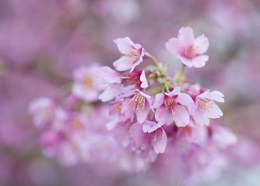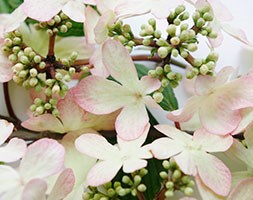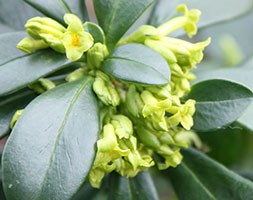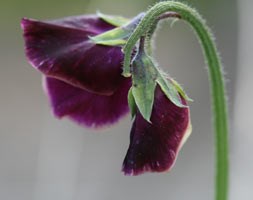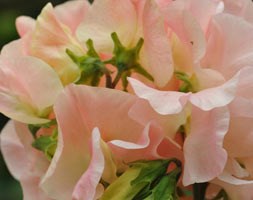New products at Crocus
by Sarah - May 24th, 2015.Filed under: Crocus, New Products.
Crocus has these new items today
Prunus x incam ‘Okame’ (ornamental cherry) £59.99
Position: full sun Soil: moist, well-drained fertile soil Rate of growth: vigorous Flowering period: March Flower colour: pink Other features: perfect for small garden Hardiness: fully hardy A bushy tree or shrub with sharply toothed dark green leaves turning vibrant shades of orange and red in autumn. Fragrant carmine-pink flowers are produced in profusion in early spring. A lovely early flowering cherry which looks great, even in small gardens. Garden care: When planting incorporate lots of well-rotted garden compost in the planting hole and stake firmly. Prune in summer to reduce the risk of silver leaf and bacterial canker. Cut back any dead, diseased or branches which cross to healthy wood.
Viburnum plicatum f. ‘tomentosum ‘Kilimanjaro Sunrise” (RHS Chelsea Flower Show Plant of the Year 2015) £44.99
Position: full sun or partial shade Soil: moderately fertile, moist, well-drained soil Rate of growth: average Flowering period: May to June Hardiness: fully hardy Very pretty, white flushed pink lacecap-like flowers appear on the tiered branches of this conical, deciduous shrub in early summer. More upright in habit than the species, it is perfect for the shrub border where space is at a premium. In autumn the leaves will take on good fiery colours before they fall providing another season of interest. Garden care: Keep the pruning of young plants to a minimum. Any vertical shoots that threaten to spoil the distinctive tiered shape of established plants should be cut back to their point of origin in summer after flowering.
Daphne ‘Albowiana’ (daphne) £29.99
Position: full sun or partial shade Soil: moderately fertile, well-drained, humus-rich soil Rate of growth: slow-growing Flowering period: March to April Hardiness: frost hardy (may need winter protection) Yellow-green flower Garden care: Keep pruning to a minimum since the plant is susceptible to die-back. Where necessary after flowering, lightly trim to remove misplaced branches and maintain a compact habit.
Rosa Gertrude Jekyll (‘Ausbord’) (PBR) (rose Gertrude Jekyll (shrub)) £24.99
Position: full sun or partial shade Soil: fertile, humus-rich, moist, well-drained soil Rate of growth: average Flowering period: July and September Other features: excellent cut-flowers Hardiness: fully hardy Beautiful, fragrant, double, deep pink flowers from July to September and greyish-green leaves. The flowers of this popular, repeat-flowering bush rose have a characteristic, old-fashioned fragrance. Performing best on fertile, moist, well-drained soil, it’s best grown towards the back of the border in sun or partial shade. This rose was voted as the nations favourite in the BBC Gardeners’ World poll in 2006 – so it is definitely worth finding a spot for it in the garden. More tolerant of shade than many other roses, it should still flower well with around 4 – 5 hours of direct sun every day. All our roses are grown in an open field and then dug up when the weather conditions are right in October or November. Some suppliers send out their roses as ‘bare root’ plants (ie without pots or compost), but we pot ours up as it helps to keep the roots hydrated and in good condition. As they are dormant throughout the winter, they will not produce any new roots until spring, so don’t be surprised if the compost falls away from the roots when you take them out of their pots. The roses can be kept in their pots throughout the winter provided they are kept well fed and watered, however ideally they should planted out as soon as possible. They will already have been cut back so no further pruning will be required, apart from snipping off any tips that have died back. Routine pruning can begin in late winter the year after planting. Garden care: If planting in winter, choose a frost-free spell when the soil is not frozen. Roses are quite deep-rooted plants so dig a deep hole roughly twice as wide as the plants roots and mix in a generous amount of composted organic matter. A top-dressing of a general purpose fertiliser can be worked into the surrounding soil and we also recommend using Rose Rootgrow at this stage to encourage better root development. This is particularly important when planting into a bed where roses have previously been grown as Rose Rootgrow is said to combat rose sickness (aka. replant disease). Remove the plants from their pots and gently spread out the roots before placing them in the centre of the hole. Try to ensure that the ‘bud union’ (the point where t
Lathyrus odoratus ‘Beaujolais’ (spencer sweet pea Beaujolais) £6.99
These sweet peas are autumn sown and grown in root trainers to promote longer deep roots. They have been grown under a cold polythene tunnel and we will despatch them as soon as they are ready to be planted outside. (See the dates above for the estimated despatch date) Position: full sun Soil: fertile, humus-rich, well-drained soil Rate of growth: average to fast-growing Flowering period: June to September Flower colour: darkest burgundy Other features: scented flowers Hardiness: hardy annual Flowers, which are so dark they almost look black, appear throughout the summer and gradually become a little paler, but still maintain a deep burgundy hue. The lower lip of the flower is a more distinct shade of purple, and these create a great contrast. Their bold colouring teams up well with lush purples and plums. In our (not very scientific) sweet pea trial on the nursery, we found that the flowers of this variety had a slight scent and were held on 6″ stems. There were not too many left in August though. All the sweet-peas in our trial produced significantly better plants when the seeds were sown in autumn rather than spring. Garden care: Incorporate lots of well-rotted organic matter in the planting hole. To make sure you keep the plants in top condition spray regularly with a fungicide as all sweet peas are prone to mildew, and feed with a high potash fertiliser, such as Tomorite for plenty of flowers. Don’t forget to keep cutting the flowers so that you get plenty more!
Lathyrus odoratus ‘Bobby’s Girl’ (spencer sweet pea Bobby’s Girl) £6.99
These sweet peas are autumn sown and grown in root trainers to promote longer deep roots. They have been grown under a cold polythene tunnel and we will despatch them as soon as they are ready to be planted outside. (See the dates above for the estimated despatch date) Position: full sun Soil: fertile, humus-rich, well-drained soil Rate of growth: average to fast-growing Flowering period: June to September Flower colour: cream and salmon pink Other features: sweetly scented flowers Hardiness: hardy annual Each rich cream petal is heavily infused with salmon-pink, which becomes more noticeable towards the outer edges. This creates a very pretty, almost picotee effect, that looks equally at home beside soft pastels and more strident shades of pink and plum. The flowers are large, and they also have a deliciously sweet scent. Garden care: Incorporate lots of well-rotted organic matter in the planting hole. To make sure you keep the plants in top condition spray regularly with a fungicide as all sweet peas are prone to mildew, and feed with a high potash fertiliser, such as Tomorite for plenty of flowers. Don’t forget to keep cutting the flowers so that you get plenty more!
Lathyrus odoratus ‘Tara’ (spencer sweet pea seed Tara) £6.99
These sweet peas are autumn sown and grown in root trainers to promote longer deep roots. They have been grown under a cold polythene tunnel and we will despatch them as soon as they are ready to be planted outside. (See the dates above for the estimated despatch date) Position: full sun Soil: fertile, humus-rich, well-drained soil Rate of growth: average to fast-growing Flowering period: June to September Flower colour: magenta pink Other features: sweetly scented flowers Hardiness: hardy annual Vibrant magenta pink flowers, that have a deliciously sweet scent, appear for several months from early summer. A favourite for the cottage garden, sweet peas are fast growing once they have had a chance to settle in, and look wonderful scrambling over a framework of brushwood stems. Alternatively plant them near a well-established shrub and let them tumble over that. Garden care: Incorporate lots of well-rotted organic matter in the planting hole. To make sure you keep the plants in top condition spray regularly with a fungicide as all sweet peas are prone to mildew, and feed with a high potash fertiliser, such as Tomorite for plenty of flowers. Don’t forget to keep cutting the flowers so that you get plenty more!
Lathyrus odoratus ‘Linda C’ (spencer sweet pea Linda C) £6.99
These sweet peas are autumn sown and grown in root trainers to promote longer deep roots. They have been grown under a cold polythene tunnel and we will despatch them as soon as they are ready to be planted outside. (See the dates above for the estimated despatch date) Position: full sun Soil: fertile, humus-rich, well-drained soil Rate of growth: average to fast-growing Flowering period: June to September Flower colour: purple-blue Other features: well scented flowers Hardiness: hardy annual Violet-blue standard petals and slightly darker wing petals, form large, softly frilled flowers, which have a light fragrance. Their colouring mixes easily with most shades, particularly pinks, purples and blues. part of the day. In our (not very scientific) sweet pea trial on the nursery, we found that the flowers of this variety had a slight fragrance and were held on 6 – 8″ stems. There were not too many left in August though. All the sweet-peas in our trial produced significantly better plants when the seeds were sown in autumn rather than spring. Garden care: Incorporate lots of well-rotted organic matter in the planting hole. To make sure you keep the plants in top condition spray regularly with a fungicide as all sweet peas are prone to mildew, and feed with a high potash fertiliser, such as Tomorite for plenty of flowers. Don’t forget to keep cutting the flowers so that you get plenty more!
Lathyrus odoratus ‘Mollie Rillstone’ (spencer sweet pea Mollie Rillstone) £6.99
These sweet peas are autumn sown and grown in root trainers to promote longer deep roots. They have been grown under a cold polythene tunnel and we will despatch them as soon as they are ready to be planted outside. (See the dates above for the estimated despatch date) Position: full sun Soil: fertile, humus-rich, well-drained soil Rate of growth: average to fast-growing Flowering period: June to September Flower colour: cream flushed with pink Other features: highly scented flowers Hardiness: hardy annual Each picotee petal has a creamy coloured base that becomes pinker towards the outer edges. The scent of the flowers is strong and delicious and the blooms are of exhibition quality. Mix it with rich pinks and plums or lilacs and purples for a great effect. Not just pretty to look at though, they will also act as a magnet for beneficial insects. Garden care: Incorporate lots of well-rotted organic matter in the planting hole. To make sure you keep the plants in top condition spray regularly with a fungicide as all sweet peas are prone to mildew, and feed with a high potash fertiliser, such as Tomorite for plenty of flowers. Don’t forget to keep cutting the flowers so that you get plenty more!







